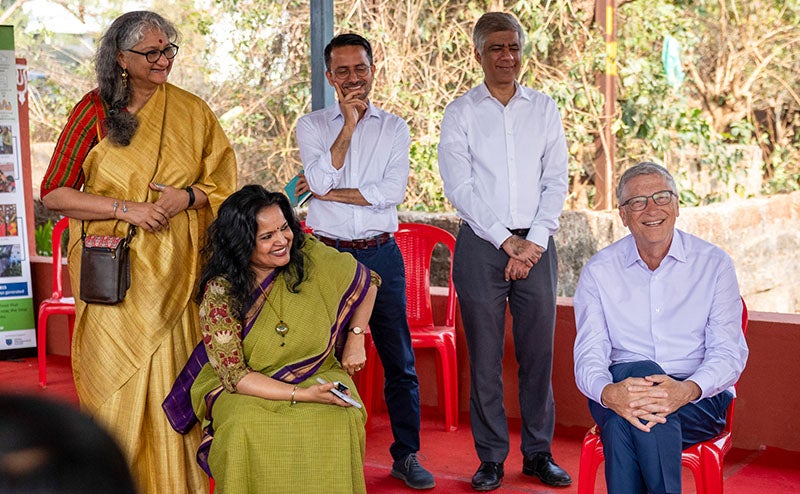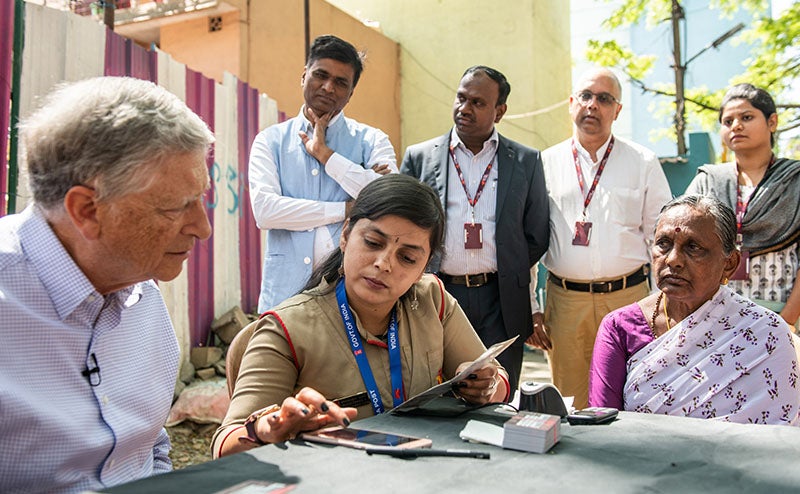It’s not often you stand on a stage next to a sample of human feces.
Earlier today, I used a beaker of poop as a prop during my speech at the Reinvented Toilet Expo in Beijing. It caused some giggles in the crowd—but I brought it out to draw attention to a serious issue that kills more than 500,000 people every year: poor sanitation.
More than half of the world’s population uses unsafe sanitation facilities. The pathogens from their waste find their way into the local water supply and make people sick. Innovation was a key driving force behind China’s economic transformation, and I believe it can do the same for improving sanitation. As I wrote on TGN today, next-generation, sewer-less toilets have the potential to transform the lives of millions of people.
I spoke about the potential and promise of these toilets during my speech. Here is the full text of my prepared remarks:
Remarks as prepared
Reinvented Toilet Expo
November 6, 2018
Beijing, China
Good morning, and thank you, Ms. Tian, for that kind introduction. I’d like to thank Mr. Chen Zhou, the China Council for the Promotion of International Trade, and the China Chamber of International Commerce for co-hosting this event.
It’s great to be in China again, and it’s fitting that we are meeting here for the Reinvented Toilet Expo. In recent decades, China has made great progress improving health and sanitation for hundreds of millions of people. President Xi’s Toilet Revolution underscores China’s commitment to accelerating progress on safe sanitation. And China has an opportunity to help launch a new category of innovative, decentralized sanitation solutions that will benefit millions of people worldwide.
Although the people in this room come from varied backgrounds—government, the private sector, development banks, academia, and philanthropy—we are all here for one reason: because more than half the world’s population doesn’t have the safe sanitation they need to lead healthy and productive lives.
Those of you in government are here because you want to find a way to solve the large and growing problem of what to do about human waste, especially in urban areas.
Those of you in the private sector are here because—with new advances in technology—you see a market opportunity to meet the needs of 4.5 billion people worldwide. Opportunities of that scale don’t come along very often.
You might guess what’s in this beaker—and you’d be right. Human feces. This small amount of feces could contain as many as 200 trillion rotavirus particles, 20 billion Shigella bacteria, and 100,000 parasitic worm eggs.
In places without safe sanitation, there is much more than one small beaker’s worth in the environment. These and other pathogens cause diseases like diarrhea, cholera, and typhoid that kill nearly 500,000 children under the age of five every year.
Unsafe sanitation also puts a huge economic burden on countries that can least afford it. Globally, it costs an estimated $223 billion a year in the form of higher health costs and lost productivity and wages.
And the problem will get worse if we don’t do something about it. Population growth, urbanization, and water scarcity over the next few decades will make it even more difficult for cities in Africa and Asia—cities that are already struggling with inadequate sanitation systems—to break the cycle of disease and poverty associated with unsafe sanitation.
I became interested in sanitation about a decade ago when I stopped working full time at Microsoft, and Melinda and I began traveling more frequently to poor countries.
We visited communities where children were playing in lanes filled with human waste, where pit latrines were emptied by hand, where the stench of community toilets was so bad that people didn’t want to use them, and where families drank water contaminated with human waste.
This was a dimension of poverty we hadn’t seen before, and it motivated us to try to do something about it. It wasn’t just the degradation and suffering that people face every day doing something that’s essential and natural for all human beings. It was also because so much of what Melinda and I seek to achieve in saving and improving lives can’t be accomplished unless people everywhere have safe sanitation.
It became clear to us that if the world was going to continue making progress against the diseases of poverty, we’d have to create a new way of looking at—and eventually solving—the global sanitation crisis.
In 2009, I posed a question to a group of scientists and engineers: was it possible to leapfrog the long-accepted “gold standard” of sanitation: flush toilets, sewers, and treatment plants?
Could we come up with a more affordable approach that could kill pathogens and keep pace with the needs of fast-growing urban areas—without requiring sewer infrastructure or reliance on scarce water resources or continuous electricity to operate?
Some people were skeptical that this was achievable. I get it. it’s hard to envision a totally different way of doing something that is so deeply rooted; that just feels like “the way things are.”
Early in my own life and career, there was a time when “the way things were” in computing was a big mainframe computer that only large corporations and governments could afford. Some of us had another idea. We dreamed about personal computers that anyone could use. A lot of people told us we were crazy. But we believed in it and found other people who shared our vision. Now, people can’t imagine the world the way it was back in the day of the mainframe.
I believe it is possible to achieve something like this in sanitation, and that’s why we have invested more than $200 million over the last seven years working with partners to develop a new generation of non-sewered sanitation technologies.
There were two main things we knew we had to accomplish. The first was to make it easier and cheaper to effectively manage fecal sludge across the sanitation service chain.
This diagram shows the scale of this problem. In the Global South, 62% of fecal sludge is not safely managed. In some cities, the problem is much worse. In one city in South Asia, 97% of human waste is untreated. And many countries are not yet even reporting how much of their waste is getting treated.
Some of the untreated human waste is in unlined pit latrines that contaminates groundwater around people’s homes. Some is collected manually, or by trucks, and is dumped into nearby fields or bodies of water. And some is collected in sewers but never gets treated. The point is that we are far from the goal the world set in 2015 of everyone using a safely-managed toilet.
To help address this problem, we worked with partners to develop a small-scale treatment plant to process fecal sludge and biosolids from pit latrines, septic tanks, and sewers. The self-powered technology—which can be located almost anywhere—is called the Omni-Processor. It takes in human waste, kills dangerous pathogens, and converts the resulting materials into products with potential commercial value—like clean water, electricity, and fertilizer.
The second challenge was to invent a pathogen-killing toilet that is also self-contained—with a tiny treatment plant built in. We call this the Reinvented Toilet, which is actually a collection of innovative technologies that use different approaches to break down human waste and destroy germs—leaving behind clean water and solids that can be used as fertilizer . . . or that can be disposed of safely outdoors without further treatment.
The initial demand for the Reinvented Toilet will be in places like schools, apartment buildings, and community toilet facilities.
As adoption of these multi-unit toilets increases—and the cost continues to drop—a new category of reinvented toilets will become available for use in people’s homes—in developing countries where people have limited resources and in developed countries for people who want or need an off-grid household toilet.
Let me show you one example of what the reinvented toilet could look like for household use—designed by the Swiss engineering firm, Helbling.
In addition, partners have made great progress developing other breakthrough technologies to control malodors, separate urine from solids, manage menstrual hygiene, and treat liquids.
I have to say, a decade ago I never imagined that I’d know so much about poop. And I definitely never thought that Melinda would have to tell me to stop talking about toilets and fecal sludge at the dinner table.
But I’m quite enthusiastic about what has been accomplished in just seven years. This expo showcases, for the first time, radically new and pilot-tested approaches to sanitation that will provide effective alternatives for collecting, managing, and treating human waste. The technologies you’ll see here are the most significant advances in sanitation in nearly 200 years.
None of this would have been possible without an exceptional worldwide team of engineers, scientists, companies, and universities committed to reinventing the urban sanitation system.
It’s exciting that solving the problem of unsafe sanitation will also create a new multi-billion-dollar business opportunity.
One of the things we’re able to do as a foundation is invest in the early stage R&D needed to create a path forward for the private sector to commercialize technologies and products that also help us achieve our goals. It’s a real win-win.
Consider just the new generation of reinvented toilets. We estimate that by 2030, this will be a $6 billion a year global business opportunity. If you add the Omni-Processor and related products and services, the market potential for decentralized sanitation solutions is likely much larger.
Like all transformative technologies, the next step is to scale these advances in collaboration with all of you.
Today, I’m pleased to say that a growing number of companies are ready to take orders for Reinvented Toilets and for the Omni-Processor. Companies like Clear, Eco-San, SCG Chemicals, and Eram Scientific Solutions are announcing their first reinvented toilet products. And CRRC, Sedron Technologies, Ankur Scientific, and Tide Technocrats are announcing their Omni-Processors.
Other commercial partners will be announcing the availability of products based on Firmenich’s innovative solution for malodor control.
In total, more than 20 companies are business-ready with innovative, non-sewered sanitation products. And I understand that Lixil, a new partner, will be telling us more about their involvement later this morning. This is the first wave of new sanitation solutions and technologies—with more to come.
But it’s not enough for companies to be interested in making and selling new products. It’s also important for national and local governments to create an enabling environment with policies and regulations that encourage innovative sanitation service models, including with the private sector.
I’m encouraged by the leadership of a growing number of countries that are embracing a smart approach to safe sanitation, such as India, South Africa, Senegal, Bangladesh, and Nepal.
China’s Toilet Revolution and its action plan for accelerating progress on safe sanitation underscores its potential as a launch market for non-sewered sanitation solutions. It’s notable that three of the partners making announcements here—Clear, Ecosan, and CRRC – are based in China. This highlights China’s interest in commercialization of off-grid sanitation solutions to meet not only the demands of China’s domestic market but also the needs of a global market ready for change.
We look forward to China adopting a high-level standard [ISO30500] for the non-sewered sanitation industry, which will further accelerate its leadership of a new commercial sanitation sector.
There is also positive momentum among finance and development institutions. The World Bank, the Asian Development Bank, and the African Development Bank are announcing commitments with the potential to unlock $2.5 billion in financing for City-Wide Inclusive Sanitation projects.
These commitments will help provide people in all parts of a city—including the poorest neighborhoods—with safely-managed sanitation services. And the banks’ pledges could help accelerate adoption of off-grid sanitation solutions—like the ones exhibited here—in low- and middle-income countries.
In addition, UNICEF and the French Development Agency will announce new strategies and commitments to accelerate deployment of innovative sanitation solutions. This is all great news.
We try to be thoughtful about the role of philanthropy—and one of the things we’re best placed to do is lower barriers and risk for the private sector and for governments to adopt new solutions to solve big problems.
That’s what we’ve tried to do with our investment so far in sanitation—so others can further develop, pilot, market, and sell these new solutions. We’re committed to supporting these efforts with an additional $200 million for continued R&D to help bring down the costs of new products for the poor, and to support market development in regions where new, non-sewered sanitation solutions can have the greatest impact.
Today, we are on the cusp of a sanitation revolution. It’s no longer a question of if we can do it. It’s a question of how quickly this new category of off-grid solutions will scale. We don’t know exactly how long that will take, but we do know it can’t happen fast enough.
Thank you.





